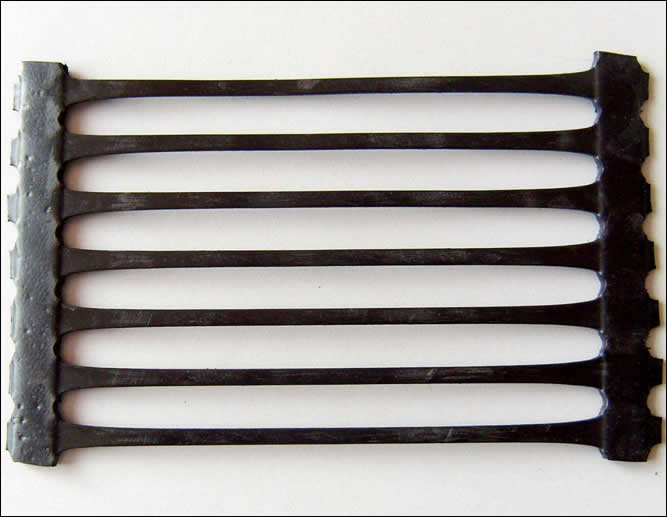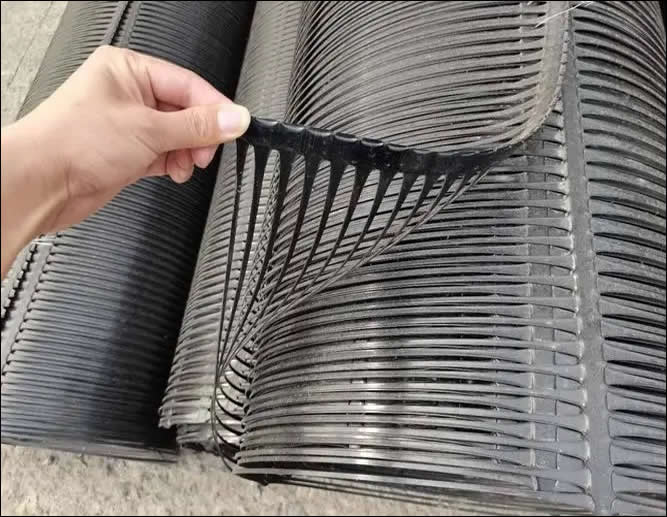Uniaxial-geogrid prdoucts-tensile strength 100-200 MPa,Good quality and good price.
Uniaxial geogrid is a type of geogrid made from a single, linear network of polyester or polymers. It is designed to reinforce soil when stretched lengthwise along the sheet. This geogrid is commonly used in civil engineering applications such as reinforcing roads, walls, and embankments.
Uniaxial-geogrid has a high tensile strength and modulus( the ratio of stress to strain in a material under stress). Its tensile strength is 100-200 MPa, providing soil with an interlocking system for force bearing and diffusion.
Structure and functions:
Uniaxial geogrids are popularly made of high-density polyethylene (HDPE) with oblong hole meshes that are stretched and pressed into thin sheets. When laid in the soil, their interlocking effect creates an efficient stress transfer mechanism, allowing local loads to spread quickly and effectively over a larger area, reducing local damage stress and prolonging the project's service life.

Uniaxial mesh geogrid provides high tensile loads in one direction, can be used for the reinforcement of walls and slope.
Uniaxial Geogrids of HDPE Mesh

Uniaxial Geogrid of high density PE for soil reinforcement and paving overlay reinforcement, one-way tensile geogrid support for reinforced asphalt and cement pavement: Laying uni-axial geogrid on the bottom of asphalt or cement pavement can reduce rutting depth, increase the pavement's fatigue life, and also reduce the thickness of asphalt and cement pavement, leading to cost savings.
Uniaxial geogrids made from polyester yarn
Type:knitted mesh
Material: Polyester
Surface: PVC or polymeric coating.
Features: Good flexibility, creep resistance, strain resistance.
Application
Uniaxial Geogrid is commonly used in embankments, tunnels, docks, roads, railroads, construction, and other fields. Its primary functions are to strengthen the roadbed and effectively distribute diffuse loads, withstand heavier alternating loads, prevent deformation and cracking caused by roadbed material losses, increase the self-supporting capability of fills behind retaining walls, combine with spray-anchored concrete construction methods for slope maintenance (saving 30%-50% in investment and construction time), reduce bending and sinking of road bases and surfaces and delay crack formations (3-9 times), lessen structural layer thickness (up to 36%), and enable simple, fast construction (greatly reducing costs).
Uniaxial geogrid used to reinforce river and sea dikes:
Geogrid can be used with gabions: Gabion boxes are permeable, slowing down wave impact and prolonging the life of the dike, reducing labor and material resources, as well as shortening the construction period.
HDPE Uniaxial geogrid is especially suitable for low temperature resistance, having been tested by the highland railroad after repeated cold and hot cycles of -45℃-50℃ 200 times. It meets the requirements and is ideal for use in the northern regions with poor geology, ice permafrost, ice-rich permafrost, and high ice content permafrost.
Uniaxial geogrid Specification Sheet
| Spec | 35 | 50 | 80 | 110 | 120 | 150 | 160 | 200 | 220 | 260 | 300 |
| Width(m) | 1 or 1.1 or 2.5 or 3 | ||||||||||
| Tensile strength≥(kN/m) | 35 | 50 | 80 | 110 | 120 | 150 | 160 | 200 | 220 | 260 | 300 |
| Nominal elongation ≤(%) | 10 | ||||||||||
| Tensile strength at 2% elongation≥(kN/m) | 10 | 12 | 26 | 32 | 36 | 42 | 45 | 56 | 80 | 94 | 108 |
| Tensile strength at 5% elongation≥(kN/m) | 22 | 28 | 48 | 64 | 72 | 84 | 90 | 112 | 156 | 185 | 213 |
Construction Method of Uniaxial Geogrid in engineering projects:
When using uniaxial geogrids for reinforced retaining walls, the construction method is as follows:
1, Set the foundation according to the design of the wall system. When precast concrete panels are selected, the precast concrete foundation should be 12-15cm thick with a width no more than 30cm, a thickness no less than 20cm, and a burial depth no less than 60cm to prevent frost swelling of the foundation.
2, Level the wall base by excavating and leveling according to design requirements. Soft soil should be compacted or refilled to the required density, slightly beyond the wall surface range.
3, The tendons should be laid perpendicular to the wall surface and secured with pins.
4, Mechanical filling should be used for wall filling, keeping a distance of at least 15cm between the wheel and the tendons. After compaction, the layer of soil should be around 20-15cm thick.
5, The wall should be wrapped with geotextile prior to filling to prevent leakage.
